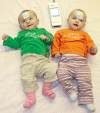Early detection of hearing impairment in newborns and infants
- PMID: 21776315
- PMCID: PMC3139414
- DOI: 10.3238/arztebl.2011.0426
Early detection of hearing impairment in newborns and infants
Abstract
Background: 1-2 out of 1000 newborns have markedly impaired hearing.
Methods: Review of the pertinent literature, which was retrieved with a selective search of the following databases: NHS EED (Economic Evaluation Database), HTA (Health Technology Assessment), DARE (Database of Abstracts of Reviews on Effectiveness), Clinical Trials, CDSR (Cochrane Database of Systematic Reviews), and PubMed.
Results: The current scientific evidence favors universal neonatal hearing screening (UNHS) for the early detection of hearing impairment. UNHS is best performed in two stages: first measurement of otoacoustic emissions and then automated assessment of the brainstem auditory evoked response. To be effective, UNHS programs must have a high coverage rate, high sensitivity and specificity, and proper tracking with a low rate of loss to follow-up. Children with positive screening tests for hearing impairment should undergo confirmatory testing as soon as possible and then receive the appropriate treatment. Early intervention is particularly critical for speech acquisition.
Conclusion: The early detection and treatment of hearing impairment in newborns and infants has a beneficial effect on language acquisition.
Figures
References
-
- Ptok M. Frühdiagnostik kindlicher Hörstörungen. Z Ärztl Forbild Qualitätssich. 2004;98:265–270. - PubMed
-
- Bekanntmachung eines Beschlusses des Gemeinsamen Bundesausschusses über eine Änderung der Kinder-Richtlinien. www.g-ba.de/downloads/39-261-681/2008-06-19-Kinder-H%C3%B6rscreening_BAn.... Einführung eines Neugeborenen-Hörscreenings vom 19. Juni 2008.
-
- IQWiG (ed.) Abschlussbericht S05-01. Köln: Institut für Qualität und Wirtschaftlichkeit im Gesundheitswesen (IQWiG); 2007. Früherkennungsuntersuchung von Hörstörungen bei Neugeborenen.
Publication types
MeSH terms
LinkOut - more resources
Full Text Sources
Medical


